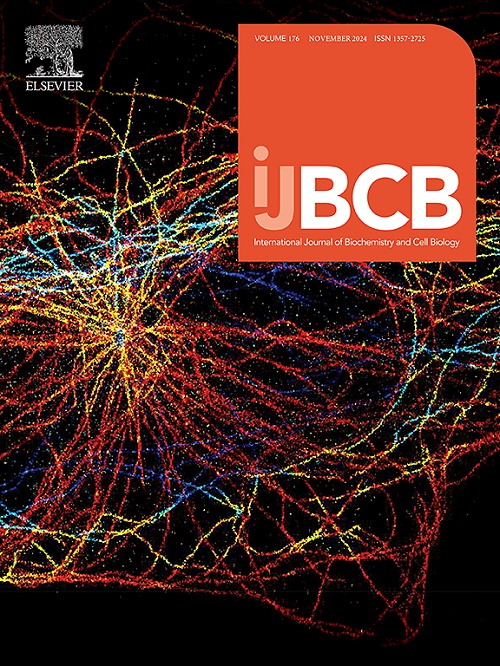Inhibition of M2 macrophage-mediated mesenchymal stem cell migration: Boldine attenuates elbow heterotopic ossification
IF 2.8
3区 生物学
Q2 BIOCHEMISTRY & MOLECULAR BIOLOGY
International Journal of Biochemistry & Cell Biology
Pub Date : 2025-04-24
DOI:10.1016/j.biocel.2025.106787
引用次数: 0
Abstract
Background
Heterotopic ossification (HO) is characterized by abnormal bone formation in soft tissues, often following trauma or surgery. Transforming growth factor-beta (TGF-β) signaling and M2 macrophage polarization play critical roles in the recruitment and differentiation of mesenchymal stromal/progenitor cells (MSPCs), promoting HO.
Methods
An elbow joint trauma-induced HO mouse model was established, where model mice were treated with dichloromethylene-bisphosphonate (Cl2MBP) liposomes or PBS liposomes to deplete macrophages. In addition, boldine was administered to evaluate its therapeutic effect on HO formation. Bone marrow mesenchymal stem cells (BMSCs) were also extracted for in vitro experiments. Quantitative real-time PCR (qRT-PCR) and Western blot were conducted to assess gene and protein expression. In vivo methods included Micro-Computed Tomography (Micro-CT) to assess bone formation, histological staining to evaluate tissue changes, immunohistochemistry (IHC) and immunofluorescence to analyze macrophage, CD73+ and CD105+ cells infiltration. In vitro, BMSCs were identified by flow cytometry and treated with interleukin-10 (IL-10) and/or boldine, and assays such as cell viability (Cell Counting Kit 8 (CCK8)), migration (Transwell), immunofluorescence, ALP staining, and Alizarin Red S staining, were conducted to assess osteogenic differentiation.
Results
Boldine treatment significantly reduced HO formation, decreased collagen deposition, and inhibited M2 macrophage infiltration (P < 0.05). In vitro, boldine reduced IL-10-induced cell activity, migration, and osteogenic differentiation of BMSCs and inhibited TGF-β and pSmad2/3/Smad2/3 protein (P < 0.05).
Conclusion
Boldine attenuates HO by inhibiting M2 macrophage-mediated MSPC migration and might involve the TGF-β signaling, suggesting its potential as a therapeutic approach for managing HO.
抑制M2巨噬细胞介导的间充质干细胞迁移:Boldine减轻肘部异位骨化
背景异位骨化(HO)的特征是软组织骨形成异常,通常发生在创伤或手术之后。转化生长因子-β (TGF-β)信号和M2巨噬细胞极化在间充质基质/祖细胞(MSPCs)的募集和分化,促进HO的发生中起关键作用。方法建立肘关节创伤性HO小鼠模型,采用Cl2MBP脂质体或PBS脂质体对模型小鼠进行巨噬细胞消耗。此外,给药boldine评价其对HO形成的治疗作用。提取骨髓间充质干细胞(BMSCs)进行体外实验。采用实时荧光定量PCR (qRT-PCR)和Western blot检测基因和蛋白的表达情况。体内方法包括显微计算机断层扫描(Micro-CT)评估骨形成,组织学染色评估组织变化,免疫组织化学(IHC)和免疫荧光分析巨噬细胞,CD73+和CD105+细胞浸润。在体外,通过流式细胞术鉴定骨髓间充质干细胞,并用白细胞介素-10 (IL-10)和/或boldine处理,并进行细胞活力(细胞计数试剂盒8 (CCK8))、迁移(Transwell)、免疫荧光、ALP染色和茜素红S染色等检测,以评估成骨分化。结果boldine显著减少HO形成,减少胶原沉积,抑制M2巨噬细胞浸润(P <; 0.05)。在体外,boldine降低il -10诱导的细胞活性、迁移和BMSCs成骨分化,抑制TGF-β和pSmad2/3/Smad2/3蛋白(P <; 0.05)。结论boldine通过抑制M2巨噬细胞介导的MSPC迁移而减弱HO,可能与TGF-β信号有关,提示其可能是治疗HO的治疗方法。
本文章由计算机程序翻译,如有差异,请以英文原文为准。
求助全文
约1分钟内获得全文
求助全文
来源期刊
CiteScore
8.10
自引率
0.00%
发文量
124
审稿时长
19 days
期刊介绍:
IJBCB publishes original research articles, invited reviews and in-focus articles in all areas of cell and molecular biology and biomedical research.
Topics of interest include, but are not limited to:
-Mechanistic studies of cells, cell organelles, sub-cellular molecular pathways and metabolism
-Novel insights into disease pathogenesis
-Nanotechnology with implication to biological and medical processes
-Genomics and bioinformatics

 求助内容:
求助内容: 应助结果提醒方式:
应助结果提醒方式:


